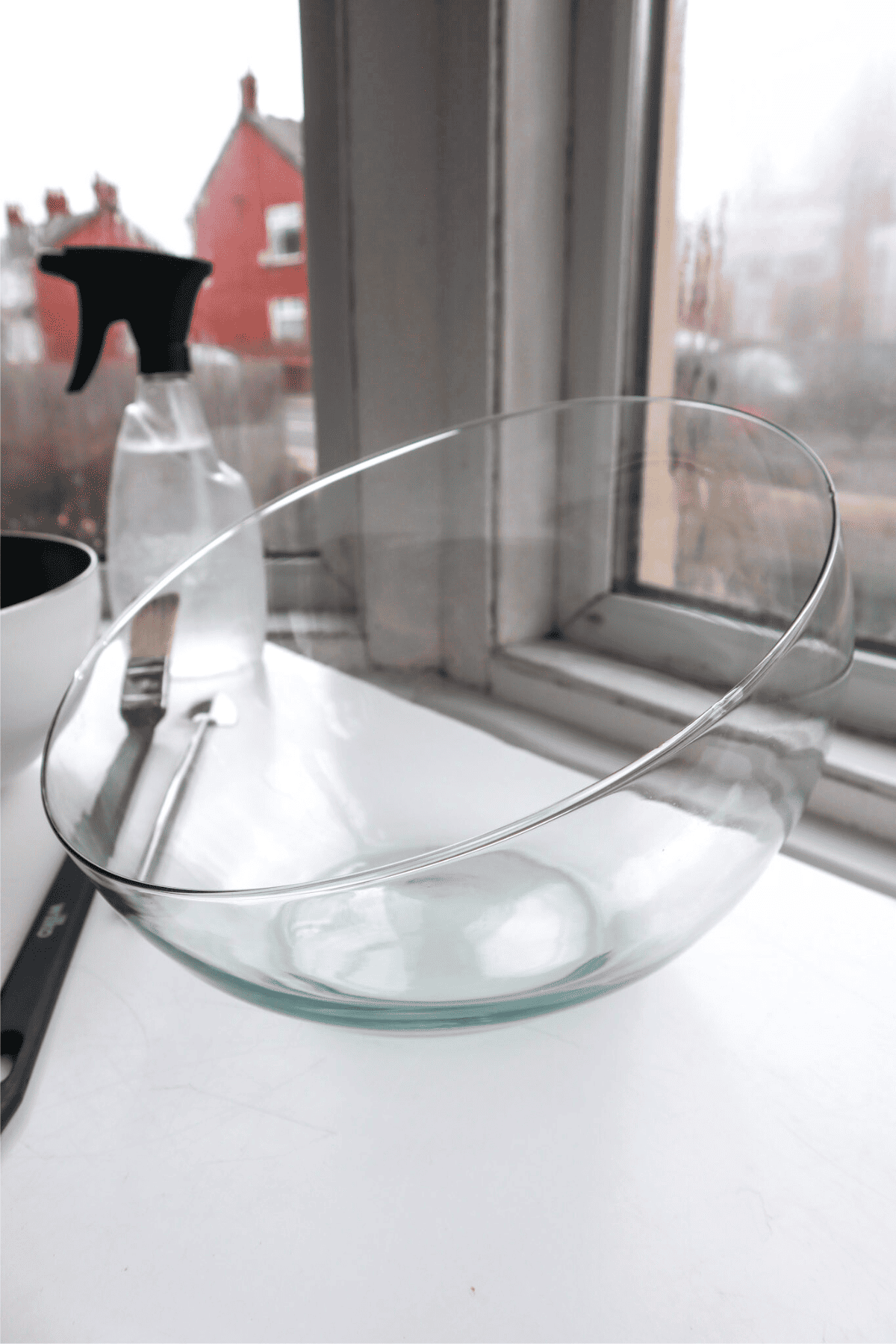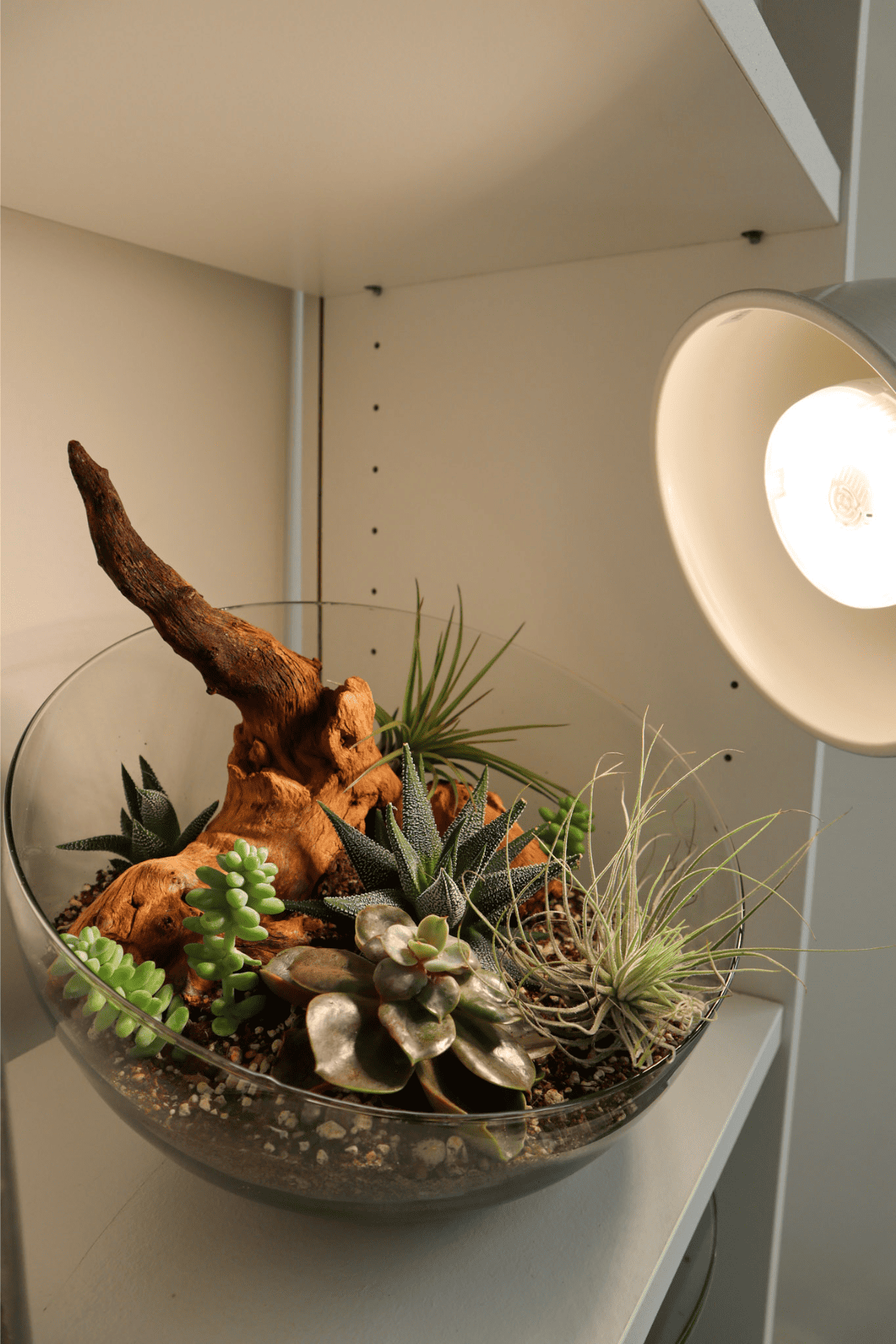If you’ve been browsing the internet for a crash course on how to design your own beautiful desert terrarium, you’ve probably noticed there are two pretty distinct schools of thought.
Many articles give the impression that a succulent or cacti build couldn’t be simpler, and other articles will tell you that it’s basically impossible to create a sustainable desert terrarium.
Though the former group certainly has a bit too casual of an outlook, the latter could probably stand to have a little faith.
Today, I’ll take you through all the details to give you the best shot at creating something beautiful, low maintenance, and, most importantly, long-lasting.

Terrarium Tribe is reader-supported. When you purchase through links on our site, we may earn an affiliate commission (at no further cost to you). 💜
What is a Desert Terrarium?
While it may be a little obvious, a desert terrarium is one that utilizes plants found in a desert.
And, when done right, these cacti and succulent terrariums can be absolutely stunning.
The open containers required give you a great opportunity to create some beautiful layering and an eye-catching 3D design.

Though, as you may have guessed by now, it isn’t as straightforward a build as you may expect; there are plenty of caveats.
In fact, what we’re talking about are more accurately described as planters rather than terrariums. But regardless of what they’re called, where there’s a will, there’s a way.
So, let’s get into the good stuff!
How to Make a Desert Terrarium – What You Need
Choosing the Right Container
Typically, cacti and succulents are famed for tolerating a little neglect.
Which may initially seem like a good fit for a closed terrarium, but these plants typically enjoy a good amount of water to pass through them followed by a period in which they can dry completely.
So, not a good fit for closed terrariums at all.
The ideal glassware for a desert terrarium will be one of decent depth and width.

Cacti and succulents are not big fans of humidity. Even if your terrarium isn’t sealed, a semi-enclosed setup is still going to facilitate a damp environment, so you want the opening to be as wide as possible.
👉 Shop glass bowl planters on Etsy.
It’s All About Drainage
As is well known, overwatering cacti and succulents is a far greater risk than underwatering. This rule goes double inside a terrarium setup.
The solution? A drainage layer, sometimes referred to as a false bottom.
You’ll want to choose a gravel that promotes airflow. I personally prefer to use leca (clay aggregate that absorbs water), but any round gravel that would promote an aerobic environment is a good option.
Aim to fill at least 1 and a half inches up of the bottom of your container.

Plants
Up until now, we’ve sort of been grouping succulents and cacti together. In so far as glassware and drainage are concerned, they have pretty much the same requirements.
The real key to a successful desert terrarium is going to be combining the right plants.
Succulents can come from a range of climates, so it’s important to research the plants you’re hoping to include before you get started.

A desert cactus is easily identifiable, thick, and prickly – you know the ones. Rather than give you a definitive list of any and all combinations of plants to use, start off with a selection of classic desert cacti.

Cross-reference their specific care requirements online to see if there’s anything anomalous about any of your choices.
👉 Shop succulents and cacti on Etsy.
Substrate
Your substrate will need to be:
- Nutritious
- Porous
- Aerated
We want our substrate to allow for good drainage and to dry out as quickly as possible.
Choosing a pebbly or gritty mix is best for this.

👉 Shop succulent + cacti soil mixes on Etsy.
Hardscape
Open planters are the perfect opportunity to show off a sleek or striking piece of hardscape.
Be it a spiraling chunk of driftwood or a rugged and beautiful dragon stone chunk.

One thing to remember when making your choice is to ensure they’re not going to harm the plants, so try to stick to tried and tested types.
Desert Terrarium Step-by-Step
Ok. We’ve given you an in-depth look at the considerations that need to be taken when selecting your materials and prepping for your design. Now, all there is to do is to create!
I would recommend wearing some gloves if you’re going to be handling cacti.
- 1) Clean your glassware with hot, soapy water and allow it to dry. It’s always best practice to ensure you’re clean from the outset.
- 2) Pour in your drainage layer. Add your mesh layer if you’re using it.
- 3) Go in with your substrate layer. Push the material around with a brush to ensure an even coverage or maximize depth in certain areas for a more natural look.
- 4) Organise your hardscape. If you have a large centerpiece, it’s best to insert this first and work your plants around it. If you’re only using smaller hardscape elements, you may want to add these in after your plants.
- 5) Using the end of a brush or other utensil, create a hole where you will place in your cacti or succulents. Carefully place in your plants and surround the base with your substrate.
- 6) Add any finishing touches. Any smaller hardscape pieces or figurines go in now. You may also want to ‘top’ your substrate with a sand layer* to strengthen your desert aesthetic.
*Doing this will also help prevent fungus gnats from breeding below the surface (pro tip right there, you’re welcome).

Care and Maintenance
Watering
All of the above means diddly-squat if you don’t give your new terrarium the proper care and maintenance it needs. As mentioned, the real danger is overwatering your ecosystem.
Cacti can be comfortably ignored for a while, but for too long, they will eventually expire.
In a planted pot, you would typically gush your cacti or succulents with water periodically, ensuring it’s thoroughly soaked. It would then, given correct drainage, dry out and remain dry for several weeks.
However, as we are operating within a finite amount of space, we need to play it smart.
Rather than soaking the roots and rather than ignoring them altogether, you should periodically give each plant a bit of water every few weeks.
It’s hard to be specific on quantity, but just remember you are trying to ensure the plants get to drink without ever sitting in water.
A tablespoon at the base of each plant should suffice. Adjust accordingly to the seasons.
Light requirements
Typically, desert plants will enjoy a high amount of light. If you’re struggling to find a spot to suit, you can always use grow lights set on a 12-hour cycle.
The benefit of a grow light setup is your ability to adjust the lighting exactly to the requirements of your plants.

Otherwise, consider a south-facing window.
Trimming Roots
Over time, if you’ve done things right, your plant’s roots will grow stronger and larger.
This means, however, that they will eventually outgrow the planter.
Although it may seem laborious, if you really want to ensure a healthy set-up, I recommend trimming off any rotting or excessively long roots once a year or so.
To do this, gently remove the plant from the soil (tweezers can make this easier) and use a pair of scissors to snip the excess or damaged roots. Replant as per the step-by-step instructions.
Over to You
And there you have it. See, naysayers? We’ve figured out a sustainable method. Go us.
Of course, you can forego these guidelines and you could still have your plants survive for up to a year in substandard conditions, but that’s no way to treat your plants.
Like any life form (mosquitoes aside), you want to maximize health and longevity to ensure your plants can live happily for as long as possible.
Kind Regards, Joe Rees, Ome.

Thank you so much for this! What a clear and detailed guide. I have about 100 succulents if I count propagations now getting big enough to move into bigger containers and will be moving them into more attractive containers this way.
The only thing I would add for readers new to succulents and cacti is to use only course sand or gravel like chick grit for a top dressing, to prevent retaining water, and to keep it pretty thin. I killed some of my first succulents with fine sand from the garden Center this way.
Thanks again.